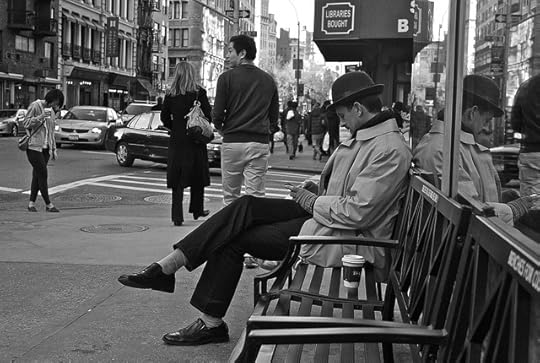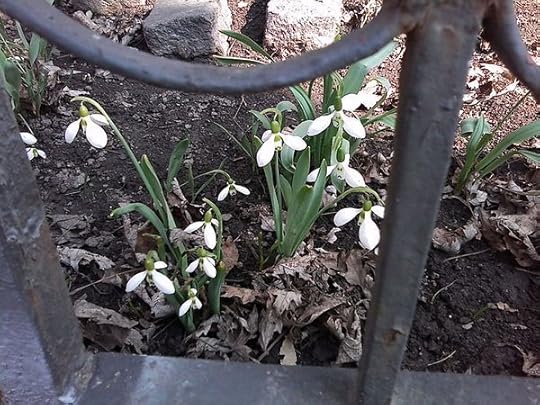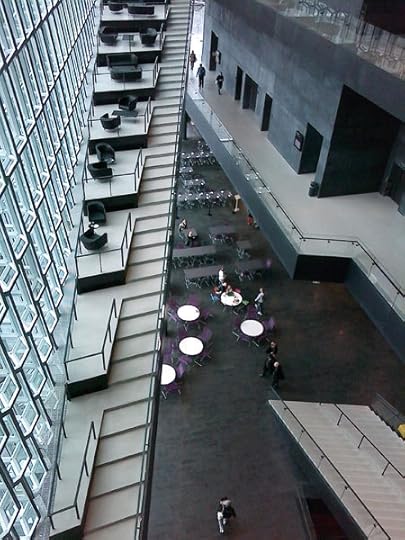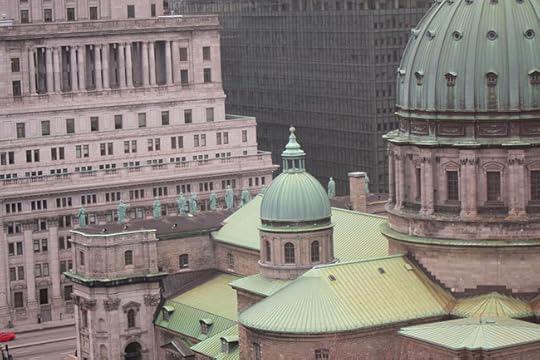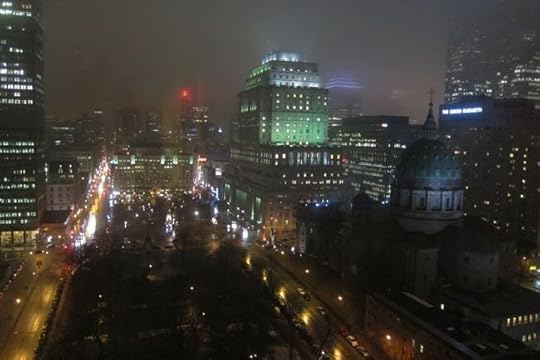Elizabeth Adams's Blog, page 101
March 31, 2012
Clarity and Chaos
Choir stalls and kneelers, Christ Church Cathedral, Montreal
Tomorrow, it begins: semaine sainte, Holy Week. It's always a complex time for me as a choir singer, with the time-commitment of rehearsals and daily services to juggle along with normal life; larger-than-usual congregations; physical fatigue; and the emotional toll of that much repetition of suffering and horrible death, along with my own doubts and questions, fears, desires, memories...
My music folder is bulging with a huge amount of repertoire; we're always somewhat under-rehearsed for this period, so I already expect to have to concentrate hard. This year we've only got six sopranos in a choir of more than thirty voices, and a lot of music divided between two soprano parts, so that ratchets up the responsibility, plus, midweek, J. and I will be returning to a chaotic home with one functioning bathroom, sheetrock dust everywhere, and our bed piled with boxes and covered with plastic, but the renovations are unlikely to finish before Easter. Wish me luck!
On the other hand, the annual Lenten retreat two weekends ago clarified some things, and I'm continuing to think about it. It was the first time I've been asked to teach meditation in a Christian context, and I led three introductory hour-long sessions, and one that went into somewhat greater depth and detail.
I had worked hard to prepare, re-reading some texts that had been helpful to me, thinking about how to talk about what meditation and contemplation are, their history within the Christian church, our debt to the East (both Eastern Orthodoxy and the Eastern religions), what meditation is not, and why it's worth doing. All that had to be simply introduced in thirty minutes or so. And then the practice itself needed to be explained, demonstrated, and tried for about fifteen minutes, with a brief discussion of distractions and how to deal with them – followed by time for questions. Of course the first session was the hardest, since there was no way to be sure about the timing, but it got easier after that.
Other people -- including the Dean, a soon-to-be-ordained seminarian, a licensed spiritual director, and a professed Anglican nun -- led other workshops on different types of prayer during the same retreat, which took place over a Friday evening and all day Saturday. With a friend's help, I set up a space for my own sessions using a beautiful rug she lent me, a wooden bench that held candles, a small spray of white freesias, and a little porcelain bowl filled with rice from my own meditation space at home: I use it to hold incense, but it's also symbolic to me of the rest of the world's people. We used some of the kneelers shown in the photo above as makeshift meditation cushions; the less flexible participants were welcome to use chairs. We were in a conference room, but when the lights were dimmed and the candles burning, the space became inviting; by the end of the retreat it felt holy.
The Dean has recently introduced several periods of silence into our services, and a number of people told me that, before these sessions, they had no idea what to do during that time, no idea what wordless prayer or meditation might feel like or how to do it. Several people said they had tried to meditate before but had been discouraged and overcome by their mental activity; one said he thought he was the only one whose mind was so noisy and busy, and felt very reassured to learn that was normal. Others had had trouble staying awake, or had never tried some of the techniques I suggested for bringing the mind back to a centered, quiet place. But most of the people were totally new to it: new, and curious to try. I was honest about my own background – my teacher was a Tibetan Buddhist and I learned through that tradition and Zen, gradually finding my way back to Christianity through Thomas Merton, and the advice of many Eastern teachers to find the parallel teachings in one's own cultural tradition. No one seemed to object!
I stressed the importance of humility on any spiritual path, and mentioned the paradox I've learned through this thirty-year wrestling match with my own ego: that not one of us is any more special than any other, and yet each of us is unique, loved, and completely special -- and that we are all connected. Meditation has shown me how desperately the ego tries to hold on, and it's taught me what happens when we are able to let go. It's not a path for the faint of heart, nor one that ever ends. Any honest introduction to meditation needs to say that.
I've always been clear with myself that I wouldn't do this sort of teaching until, or unless, I was asked. Now I'm not sure where it will lead, but in conjunction with my friend I'll be offering two additional sessions at the cathedral on Wednesday, leading up to the most contemplative and serious days of the liturgical year. Through all of this I'm listening to the process, watching the faces as I speak, and thinking hard about the questions that are asked. I know, for sure, that sitting with these participants for many hours gave me a degree of calm I haven't felt in a long time, and it's lasted; I'm grateful to have that, on the eve of this Holy Week.
As part of my own practice, I'll be posting a photograph and some sort of reflection – much shorter than this one! -- each day for the next week.
March 30, 2012
Virginia and the Greeks
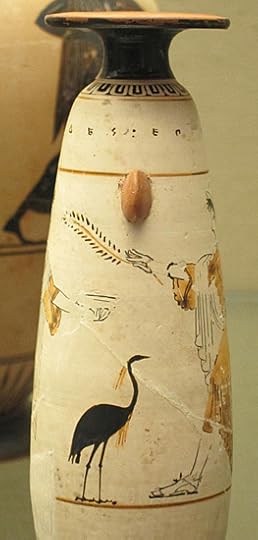 "Penelope crosses the room, Telemachus goes to bed; Nausicaa washes her linens; and their actions seem laden with beauty because they do not know that they are beautiful, have been born to their possessions, are no more self-conscious than children, and yet, all those thousands of years ago, in their little islands, know all that is to beknown. With the sound of the sea in their ears, vines,meadows, rivulets about them, they are even more aware than we are of a ruthess fate. There is a sadness at the back of life which they do not attempt to mitigate. Entirely aware of their own standing in the shadow, and yet alive to every tremor and gleam of existence, there they endure, and it is to the Greeks that we turn when we are sick of the vagueness, of the confusion, of the Christianity and its consolations, of our own age."
"Penelope crosses the room, Telemachus goes to bed; Nausicaa washes her linens; and their actions seem laden with beauty because they do not know that they are beautiful, have been born to their possessions, are no more self-conscious than children, and yet, all those thousands of years ago, in their little islands, know all that is to beknown. With the sound of the sea in their ears, vines,meadows, rivulets about them, they are even more aware than we are of a ruthess fate. There is a sadness at the back of life which they do not attempt to mitigate. Entirely aware of their own standing in the shadow, and yet alive to every tremor and gleam of existence, there they endure, and it is to the Greeks that we turn when we are sick of the vagueness, of the confusion, of the Christianity and its consolations, of our own age."
Virginia Woolf, A Common Reader: First Series, "On Not Knowing Greek."
March 29, 2012
Parmanu's New York Diary
"Man with Hat" (c) 2012 by Parmanu
"I do not know what it is like to live there, but as a visitor, no matter how many times I've been to the city before, New York does not fail to impress. Like Venice, Paris, or Mumbai, its character assails you the moment you step into the city. Arriving by train into the New York Penn station, the same passengers who were relaxed and laid back when they boarded the train in the suburbs spring into motion, like toys with wound up keys, and march with an infectious purpose through the station into the maze-like streets of Manhattan..."
Highly recommended reading and seeing, from one of my favorite writers and blogger friends.
March 27, 2012
Somewhere
(Self-portrait at Papineau, March 24, 2012)
Where am I these days? Somewhere between the intimate familiar and the anonymous stream of the city. We're still living downtown while the renovation work continues on our apartment, and during that time we're traveling between a hotel, our apartment, and our studio using a combination of the metro, buses, our feet, and our car. The trip that used to take 15 minutes now takes 45 each way, but it's interesting: we slide into the flow and become riders, watchers, waiters, learning new paths and signs: the African shop at Peel; the Caribbean guitarist who plays each morning at the foot of the Papineau escalator; the searchlight on top of Ville Marie sweeping through the night sky.
One result of all the travel and moving around I've done over the last decade is that I've become much more comfortable with dislocation and change. I used to be very rooted to my home, which was very much my "home base," and it would take me a long time to adjust to being somewhere else, or to disruptions in daily life. Now I'm OK with living out of a suitcase for a while, or that odd feeling of waking up and not being quite sure, for those first minutes, of where I am. I used to experience a lot more anxiety, both before and during travel. The circumstances that have caused this shift have not all been happy or fortuitous, though some have; I guess that's just life and getting older, because change happens whether we want it or not. We can adjust, or we can fight it and suffer.
I had a long talk with a friend recently, about those sorts of things. She was thinking about her eventual retirement from a demanding, intense career, and beginning to plan ahead. We both observed that some people spend years in denial about aging and the changes that it brings, and then get blindsided because they simply aren't prepared once they actually retire, or face some limitation caused by health, a partner's death or illness, or some other change in life situation. It's as if some people become more reed-like as they age, more capable of coping with the gales that inevitably strike, and others become more brittle, more fragile, more prone to bitterness, anger, and remorse, and as a result, they often isolate themselves. What are we identified with? A job? Professional prestige? Children? Marriage? A home, a lifestyle? Physicality? Being "in the loop?"
I used to feel so much more brittle and fearful as I thought about what might happen, but now, as that "ïf" comes closer, I can see that I'm actually becoming somewhat softer, more flexible and more resiliant, more able to go with the flow of things -- and that gives me hope. Curiosity helps, humor helps...but mainly I think we have to face reality, think ahead, develop real interests and relationships that can sustain us later on, and, if possible, put ourselves into situations that mimic some aspects of a potential future. For me, that definitely won't be shuffleboard in Florida...!
(Hmmm...just noticed that this is my 1400th post since moving the blog to TypePad in May 2005.)
March 23, 2012
La dame aux camélias: talking to Marly, part 2
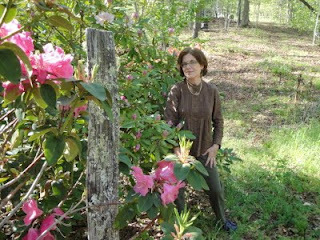 We're talking to Marly Youmans, author of A Death at the White Camellia Orphanage. And, OK, those aren't camellias but azaleas in the picture, but it's definitely Marly. This is part 2 of a two-part interview that began yesterday.
We're talking to Marly Youmans, author of A Death at the White Camellia Orphanage. And, OK, those aren't camellias but azaleas in the picture, but it's definitely Marly. This is part 2 of a two-part interview that began yesterday.
_____________
BETH: Among the books that you've written so far, what's unique or special for you about this one? (By that I mean special about the characters or story.)
MARLY: In A Death at the White Camellia Orphanage, I addressed some questions that rose up in my childhood and were never answered to my satisfaction. When my father was a poor sharecropper's boy, he ran away from home several times and rode the rails. I know that once he was found in Southern Florida, but that's about all I have to tell; I wish that I knew more. I knew the places where he grew up, knew that he left home at seventeen and became a tailgunner in World War II--knew that he went to Emory on his return. I could remember something of his time as a graduate student at LSU, before he worked as a professor of analytical chemistry. But I knew little about those teenage years and what the rails (or being a tailgunner, or learning to fly during the Korean War, for that matter) meant to him.
Other questions about our family remained an enigma. My great-grandfather Nathaniel was a bridge builder in south Georgia who fathered twenty-two legitimate children, as well as two mixed race children. After the neighbor lady who was the mother of these children died, the two little boys were brought up in the family. One of them was my grandfather's favorite brother. These bits of news out of the past startled me and made me realize that the history I had been taught was only a partial thing.
Often an absence or a mystery is what draws a writer to a story. With language I toss some bridges over gaps, and though my words cannot conjure missing family history, they can conjure a story, an angle of vision, and a sort of rightness and fullness.
BETH: Do you feel your craft as a novelist advances with each book? What were the particular challenges you faced in A Death at the White Camellia Orphanage?
 MARLY: No doubt some mastery is gained, but the curious thing about me and the writing of novels is that I tend to veer in a wildly different direction each time I sit down to write. New directions mean that I am starting over, and that what helped me last time is probably not going to help me much this time. If a writer relies on what she did the time before, she may please a publisher because a good many publishers don't like surprises, but she won't surprise herself... And what's the use of a creation that is not fresh and free enough to surprise its maker?
MARLY: No doubt some mastery is gained, but the curious thing about me and the writing of novels is that I tend to veer in a wildly different direction each time I sit down to write. New directions mean that I am starting over, and that what helped me last time is probably not going to help me much this time. If a writer relies on what she did the time before, she may please a publisher because a good many publishers don't like surprises, but she won't surprise herself... And what's the use of a creation that is not fresh and free enough to surprise its maker?Along the way I was concerned about the book's picaresque, rambling character, and that the story remain vital despite the choice of a form can be somewhat less propulsive. The first two chapters rocketed out quickly and had a good deal of force; then I had the job of making the rest of the book live up to the start.
BETH: Thank you, Marly! I can't wait to read the book and I hope others feel the same way. It's available for pre-order at bookstores and online, and will be published on March 30.
March 22, 2012
La dame aux camélias: talking to Marly, part 1
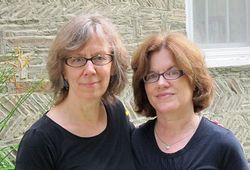 Marly Youmans (at right in the photo) is a friend, a prolific and gifted writer of poetry and fiction, a blogger, and a neighbor of sorts: she lives and writes in Cooperstown, New York, just a hop of one valley over from where I grew up. I met Marly through qarrtsiluni, where she's been a frequent contributor and also an issue editor. Later this year I'll be publishing her book-length, post-apocalyptic epic poem Thaliad at Phoenicia Publishing. But right now, we're having a conversation about her new novel, "A Death at the White Camellia Orphanage," (Mercer University Press, 2012, The Ferrol Sams Award for Fiction) available for pre-order at real bookstores and online. Here's part 1, below the book cover:
Marly Youmans (at right in the photo) is a friend, a prolific and gifted writer of poetry and fiction, a blogger, and a neighbor of sorts: she lives and writes in Cooperstown, New York, just a hop of one valley over from where I grew up. I met Marly through qarrtsiluni, where she's been a frequent contributor and also an issue editor. Later this year I'll be publishing her book-length, post-apocalyptic epic poem Thaliad at Phoenicia Publishing. But right now, we're having a conversation about her new novel, "A Death at the White Camellia Orphanage," (Mercer University Press, 2012, The Ferrol Sams Award for Fiction) available for pre-order at real bookstores and online. Here's part 1, below the book cover:
 A Death at the White Camellia Orphanage tells of a young boy's travels through the black heart of Depression America and his search for light both metaphorical and real. Writing with a controlled lyrical passion, Marly Youmans has crafted the finest, and the truest period novel I've read in years.
A Death at the White Camellia Orphanage tells of a young boy's travels through the black heart of Depression America and his search for light both metaphorical and real. Writing with a controlled lyrical passion, Marly Youmans has crafted the finest, and the truest period novel I've read in years.
--Lucius Shepard
In A Death at the White Camellia Orphanage Marly Youmans gives us a beautifully written and exceptionally satisfying novel.Youmans has achieved that rarest of all accomplishments: she has created a flawed hero about which we care. A Death at the White Camellia Orphanageis one of the best books I have read.
--Raymond L. Atkins
____________________________
BETH: Marly, your novels have a very convincing sense of place. How did you decide on the setting for Death at the White Camellia Orphanage?
MARLY: In the case of A Death at the White Camellia Orphanage, I used a setting that had not changed much since the Depression--that is, the rickety house where my paternal grandparents lived and sharecropped land owned by a relative. The description of the orphanage relies on an intimate knowledge of the swamps and fields and dirt roads close by, the places where we would go to pick fruit as children, the swelter of heat, the cruel, ingenious insects, and the dearth of comfort in and outside of the house and its tiny outbuildings. It simply felt like the right place for the orphanage when I began dreaming up Pip and his life.
Staying at a poor sharecropper's house near Lexsy, Georgia every summer was a great boon to me as an imaginative child. I could easily step away from the 24-party line and the minimal utilities and imagine a medieval world. To go there was to live in another time in which shelter was minimal. (A short jaunt down the road and I was at Collins, where I stayed in yet another time--my maternal grandparent's house, a Queen Anne built by my grandfather and still redolent of its era.)
BETH : Do you do a lot of research to achieve this, or is it based on personal experience?
MARLY: However, I don't usually pillage settings I know because I like to make things up. So I sometimes research elements of a landscape--eucalyptus flowers, for instance, blossoms that I haven't seen in decades. I admit to borrowing the feel of life by an upstate lake like Cooperstown for Pip's northern travels, and a childhood in which we moved every three years definitely informs the book's landscapes. Certain elements that seemed very strange to me when I lived outside the South as a child--clouds of cottonweed seeds, for example--crept in as elements of strangeness around Pip.
The interview concludes tomorrow...
March 20, 2012
NINE
It's Cassandra's birthday today: nine happy years of blogging! Thanks for being here with me. I'd be delighted to hear from you and know how long you've been reading here. I've loved writing this blog, but it's the readers who've kept me going -- thanks to each and every one of you.
And since it's a glorious warm day here in Montreal, I feel like everyone is celebrating. J. says, "as soon as you see girls riding on the handlebars of their boyfriend's bikes, you know it's spring!" I watched a big puffy male pigeon courting a female who was trying her best to ignore him, and as I walked through the park this morning the redwing blackbirds were singing like crazy in trees full of buds, so those special spring behaviors seemto be bursting forth and spreading across all the kingdoms: green, furred, and feathered. In the country there are probably froggy choruses already too, but that seems as amazing for this time of year as it is for me to be without a coat and hat. I hope it's nice where you are, too.
March 19, 2012
Harpa Honeycomb
(for qB)
Because I've been spending more time lately in downtown Montreal, I've been thinking about contemporary architecture, a great love of mine -- and then a friend's post reminded me of honeycomb, and this building in Reykjavik that I visited just about exactly 6 months ago.
It's the city's new concert hall, named Harpa, built amid controversy over whether such an expenditure could be justified in the wake of Iceland's financial crisis. It was designed by the Danish firm Henning Larsen Architects and Icelandic architectural firm Batteríið Architects. Our friends there were not wild about the building itself, which sits on the wharf right at the edge of the ocean. As I went through my photographs I realized I didn't have any good pictures of the exterior -- I loved the different facades, but not the extra colors and LED lights which I felt detracted from the building's sculptural quality, especially at night -- but I was completely intrigued by the interior of the building, which I found both unusual and beautiful. The surfaces and lack of color -- all greys and black, except for an occasional touch of bright yellow or purple -- give it a restrained Scandinavian/Germanic ambience, quite different from most of what gets built in North America.
"The building's name Harpa refers to the musical instrument, the harp. It is also the name of the first month of spring in the Nordic calendar - and for the people of Iceland this means the promise of better times."
Steinunn Birna Ragnarsdóttir
Musical Director of Harpa
Most astonishing are the glass sides, constructed of steel and glass in a honeycomb-inspired design that seemed at first to be in a regular pattern, but revealed itself to have deliberate irregularities. I couldn't imagine how it had been designed and engineered, let alone built, and our friends told us that Asian construction workers had been hired to actually do the building work, because they were the only ones with experience in this type of construction. The descriptions of the building on the official website, unfortunately, don't include many details about how the design was developed and chosen, or how the engineering challenges were solved, though at the architect's own website, they say that in order to develop these ideas "the team worked with three-dimensional computer models, finite element modelling, various digital visualisation techniques as well as maquettes, models and mock-ups."
However, an article at arcspace.com provided some insight into the design itself. (The photos below are by Nic Lehoux, and Bára Kristinsdóttir respectively, from the gallery of press photos at the Harpa official website.)
The plaza in front of the Concert Hall is designed to generate a unique atmosphere where the dark base, referring to the black Icelandic sand, emphasizes the play of light and colors in the facades. The water pools mirror the facades and provide the plaza with a well-defined expression. Approaching the harbor from the city, the Concert Hall rises from the black base of the front plaza.
Harpa's multifaceted glass facades are the result of a unique collaboration between renowned artist Olafur Eliasson and Henning Larsen Architects. The design is based on a geometric principle, realized in two and three dimensions. Light and transparency are key elements.
Made of a twelve-sided space-filler of glass and steel called the "quasi brick," the building appears as a kaleidoscopic play of colors, reflected in the more than 1,000 quasi bricks composing the southern facade. The remaining facades and the roof are made of sectional representations of this geometric system, resulting in two-dimensional flat facades of five and six-sided structural frames. The crystalline structure, created by the geometric figures, captures and reflects the light – promoting the dialogue between the building, city and surrounding landscape.
We weren't able to enter any of the four concert halls, but they all look very beautiful. We did listen to a midday informal jazz concert in the cafe area (3rd picture above) along with many contented Reykjavik residents and visitors. Next time we'll be sure to book tickets to a concert; Harpa is the new home of the Icelandic Symphony, but presents events from theatre and opera to Bjork.
I only had my phone camera that day, but if you'd like to see more photos of the exterior and interior, here's a link to high-quality press photos of the building.
March 15, 2012
Grey Morning at Marie Reine du Monde
Standing atop the façade of Mary, Queen of the World, the line of saints looks down on the city, as I look down on them...
Life is feeling pretty chaotic right now, but we're managing...yesterday the workmen set off the fire alarm in the apartment, today they want the bathtub delivered but it can't be, not until Monday...flurries of phone calls...The silver lining, I guess, is that I'm learning a lot of new French words. Bride de carrelage, par example = "tile flange." Who knew?
Today I went to the apartment early to talk to the workcrew and try to see if there was anything we could do about the delay. I met Benoit and Simon, and we talked, mostly in French -- and I was happy that I was able to understand them and make myself understood. It's getting better. Osmosis!
For a complete contrast, tomorrow evening and all day Saturday I'll be talking about and teaching contemplation/meditation at the cathedral's annual Lenten retreat. I think I'm the one who'll benefit the most!
March 13, 2012
Dominion Square
Dominion Square, Montreal, looking north, with the Sun Life building (greenish, top center), Mary Queen of the World basilica at near right, the Queen ELizabeth Hotel behind it. (Click for a larger view.)
And this is where I am, at the moment: in a hotel room on the 20th floor, looking out at this scene as the fog from the St. Lawrence settles lower and lower over the city's towers.
As I mentioned earlier, the bathrooms in our apartment are being torn out because of the flood from the apartment above us, several months ago. There was water pouring throughthe light fixtures onto our floor, and when the insurance adjuster checked, he said there was a lot of moisture in the walls, floors and ceilings -- which meant the danger of champignons - oh horror! - the catch-all term here for mold, fungus, and mildew. Finally the insurance company's contractor has gotten around to doing the repairs, and we're paying for an upgrade to the fixtures in the master bath. It's nothing fancy, but it will be nice. In the meantime though -- no water, no bathroom, and no heat. We slept on our living room sofabed last night, with all our furniture pied around us, and the rest of the apartment curtained off with plastic sheets and masking tape, the floor covered with dust. Today we fled.
Fortunately our insurance policy also pays for lodging in such circumstances. This is a new experience for us, and probably won't ever happen again! So J. bid for hotel rooms online, and scored this very nice one at a very reasonable price, and in the lobby I spoke French and J. smiled his best smile for the desk clerk, a kindly older man, and asked, "Do you have a room with a nice view?" ...We also bought weekly passes for our OPUS cards, which work in the buses and metro system, and allow for unlimited rides; that way we don't need to drive down here, hassle with the traffic, and pay for parking. During the day we'll just take the metro back up to our studio and work and cook as usual, and we hope - in spite of the novelty - that we can move back home soon.
In the meantime I'll try to take advantage of the location to show you some different views of our fair city -- downtown is quite a change from our quaint, European-style neighborhood, especially from up here!


